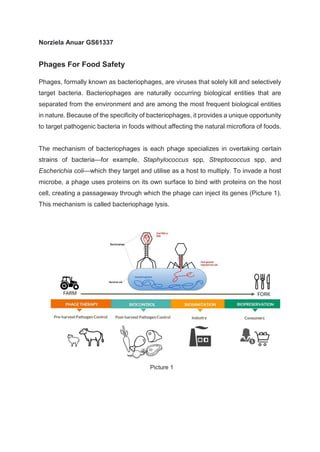Phages for food safety
Bacteriophages are viruses that selectively target and kill specific strains of bacteria without harming other microflora. They work by binding to receptors on the bacterial cell and injecting their genes, causing the host cell to burst and multiply the phages. Phages offer advantages for food safety applications by eliminating pathogens from foods topically or through packaging without impacting taste or quality. While phages only target specific bacteria, limitations can be overcome by using multiple phage strains or combining with antibiotics. Proper coordination is needed as disinfectants may inactivate phages during food processing. Overall, phage biocontrol is an effective natural method to control foodborne pathogens without harming normal microflora or changing food properties

Recommended
Recommended
More Related Content
What's hot
What's hot (20)
Similar to Phages for food safety
Similar to Phages for food safety (20)
More from Norziela Anuar
More from Norziela Anuar (7)
Phages for food safety
- 1. Norziela Anuar GS61337 Phages For Food Safety Phages, formally known as bacteriophages, are viruses that solely kill and selectively target bacteria. Bacteriophages are naturally occurring biological entities that are separated from the environment and are among the most frequent biological entities in nature. Because of the specificity of bacteriophages, it provides a unique opportunity to target pathogenic bacteria in foods without affecting the natural microflora of foods. The mechanism of bacteriophages is each phage specializes in overtaking certain strains of bacteria—for example, Staphylococcus spp, Streptococcus spp, and Escherichia coli—which they target and utilise as a host to multiply. To invade a host microbe, a phage uses proteins on its own surface to bind with proteins on the host cell, creating a passageway through which the phage can inject its genes (Picture 1). This mechanism is called bacteriophage lysis. Picture 1
- 2. Bacteriophages are used for food safety applications as a biocontrol, bio sanitation and biopreservation to eliminate pathogenic bacteria (or significantly reduce their levels in) foods without eliminating good bacteria that present on fresh and processed foods, either via direct spraying on food surfaces or through the packaging materials. When applied to live animals, phages can be administered via animal feed or spray- applied to hides or feathers prior to slaughter. It's also used as a disinfectant for surfaces within the food processing facility. Usage of these lytic bacteriophages makes the food safer to eat without sacrificing quality, taste and nutritional value of the foods. While the biological properties of lytic bacteriophages provide advantages for improving food safety, these properties also lead to some of the limitations and drawbacks to phage biocontrol. As mentioned previously, bacteriophages are highly specific and as such, they are only effective against the pathogen of interest. Still, if foods are contaminated with multiple pathogens, a combination of phage biocontrol products could be used to target more than one pathogen. Other than that, the bacteria also can become resistant to the phages at some point during the treatment. To overcome this problem, one of them is to identify multiple phage strains that can infect the bacteria so that if it becomes immune to one phage strain, other strains are still capable of infecting it. Another way is to combine phage therapy with antibiotic treatment. Since bacteriophages themselves are also microorganisms, commonly used disinfectants or chemicals could inactivate them, so their use needs to be carefully coordinated within the processing line. In addition, the currently marketed phage preparations require refrigerated storage (typically 28°C). Thus, a good understanding of the biological properties of bacteriophages and designing optimal application regimens that consider those properties is essential for the best possible efficacy of phage biocontrol intervention. Despite some lingering challenges, phage biocontrol is increasingly being recognized for its effectiveness in controlling foodborne pathogens in the food processing industry. The biggest advantage of using phage biocontrol is that wild type lytic phages are natural antimicrobials that allow targeted elimination of problem foodborne pathogens
- 3. in foods without deleteriously impacting the natural microflora of foods and other nutritional or organoleptic qualities of foods. References: 1. Current Issues in Molecular Biology, MDPI (2021) Vol. 40: 267-302, https://doi.org/10.21775/cimb.040.267 2. https://www.evergreen.edu/magazine/bacteriophage-good-guys-virus-world 3. https://www.mmgazette.com/using-viruses-to-treat-bacterial-infections-ahmad- tarmizi-abdul-halim/
